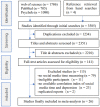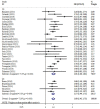Time Spent on Social Media and Risk of Depression in Adolescents: A Dose-Response Meta-Analysis
- PMID: 35564559
- PMCID: PMC9103874
- DOI: 10.3390/ijerph19095164
Time Spent on Social Media and Risk of Depression in Adolescents: A Dose-Response Meta-Analysis
Abstract
Adolescent depression is a worldwide public health concern and has contributed to significant socioeconomic burden. Investigating the association between time spent on social media (TSSM) and depression may provide guidance toward the prevention and intervention of adolescent depression. However, related literature reported mixed findings in terms of the relationship between TSSM and depression in adolescents. Hence, we conducted a comprehensive dose−response meta-analysis to clarify this issue. We conducted a systematic title/abstract and topic search of the relative terms in Web of Science, PubMed, PsycINFO databases through 9 January 2022. Odd ratios (ORs) were used to examine the pooled effect size of the association between TSSM and risk of depression. Dose−response analysis was evaluated by a generalized least squares trend estimation. Twenty-one cross-sectional studies and five longitudinal studies including a total of 55,340 participants were included. Overall, more TSSM was significantly associated with a higher risk of depression symptoms (OR = 1.60, 95%CI: 1.45 to 1.75) with high heterogeneity (Q(29) = 105.9, p < 0.001; I2 = 72.6%). The association was stronger for adolescent girls (OR = 1.72, 95%CI: 1.41 to 2.09) than boys (OR = 1.20, 95%CI: 1.05 to 1.37). Five studies with seven reports were included in dose−response analysis. There was a linear dose−response association of TSSM and risk of depression. The risk of depression increased by 13% (OR = 1.13, 95%CI: 1.09 to 1.17, p < 0.001) for each hour increase in social media use in adolescents. TSSM is associated with depression in a linear dose−response and gender-specific manner, which suggests the need for better monitoring of adolescent social media use. However, motivation, content, and engagement on and exposure to social media use may also be important contributing factors, making it necessary to interpret the current findings with caution. Therefore, further research is required to clarify not only the causal link between TSSM and depression by randomized control studies but also the influence of other factors, such as active vs. passive social media use or different types of engagement or environments in which social media is used.
Keywords: adolescents; depression; dose–response; meta-analysis; social media use.
Conflict of interest statement
The authors declare no conflict of interest.
Figures




References
-
- Kietzmann J.H., Hermkens K., McCarthy I.P., Silvestre B.S. Social media? Get serious! Understanding the functional building blocks of social media. Bus. Horiz. 2011;54:241–251. doi: 10.1016/j.bushor.2011.01.005. - DOI
Publication types
MeSH terms
LinkOut - more resources
Full Text Sources

